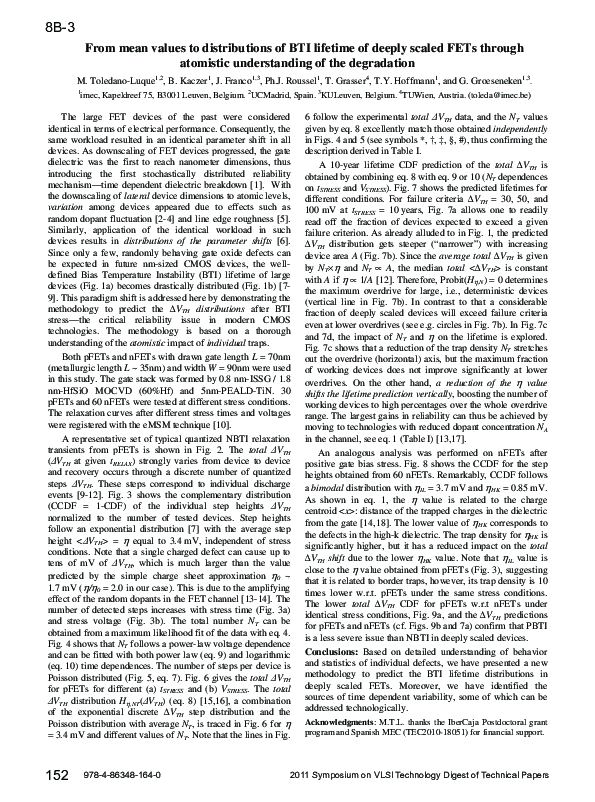Academia.edu no longer supports Internet Explorer.
To browse Academia.edu and the wider internet faster and more securely, please take a few seconds to upgrade your browser.
From mean values to distributions of BTI lifetime of deeply scaled FETs through atomistic understanding of the degradation
From mean values to distributions of BTI lifetime of deeply scaled FETs through atomistic understanding of the degradation
2011
Related Papers
IEEE International Reliability Physics Symposium Proceedings
Origin of NBTI variability in deeply scaled pFETs2010 •
IEEE Transactions on Electron Devices
Statistical Simulation of Progressive NBTI Degradation in a 45-nm Technology pMOSFET2000 •
2010 •
Abstract-The statistical distribution of negative bias temperature instability (NBTI) in deca-nanometer p-channel FETs is discussed. An exponential distribution of threshold voltage shifts due to a single charge trapped in the gate oxide is observed, resulting in single-charge shifts exceeding 30 mV in some of the studied 35-nm-long and 90-nm-wide devices. The exponential distribution is justified with a simple channel percolation model. Combined with the assumption of the Poisson-distributed number of trapped gate oxide charges, an analytical description of the total NBTI threshold voltage shift distribution is derived. This allows, among other things, linking its first two moments with the average number of defects per device, which is found < 10 in the studied devices. Index Terms-MOSFETs, negative bias temperature instability (NBTI), reliability, variability.
2010 •
The Scientific World Journal
Effects of Gate Stack Structural and Process Defectivity on High- k Dielectric Dependence of NBTI Reliability in 32 nm Technology Node PMOSFETs2014 •
We present a simulation study on negative bias temperature instability (NBTI) induced hole trapping inE′center defects, which leads to depassivation of interface trap precursor in different geometrical structures of high-kPMOSFET gate stacks using the two-stage NBTI model. The resulting degradation is characterized based on the time evolution of the interface and hole trap densities, as well as the resulting threshold voltage shift. By varying the physical thicknesses of the interface silicon dioxide (SiO2) and hafnium oxide (HfO2) layers, we investigate how the variation in thickness affects hole trapping/detrapping at different stress temperatures. The results suggest that the degradations are highly dependent on the physical gate stack parameters for a given stress voltage and temperature. The degradation is more pronounced by 5% when the thicknesses of HfO2are increased but is reduced by 11% when the SiO2interface layer thickness is increased during lower stress voltage. However...
Facta universitatis - series: Electronics and Energetics
NBT stress and radiation related degradation and underlying mechanisms in power VDMOSFETsIEEE Transactions on Electron Devices
Interplay Between Statistical Variability and Reliability in Contemporary pMOSFETs: Measurements Versus Simulations2014 •
Dumlupınar Üniversitesi İslami İlimler Fakültesi
ANADOLU SELÇUKLU MEDRESELERİNİN CEPHESEL VE MEKÂNSAL KALİTE ANALİZİ: SİVAS KENTİ ÖRNEĞİ / Analyzing the Spatial and Facade Quality of the Madrasas of Anatolian Seljuks: The Case of Sivas City MadrasasÖz: Türkler, Anadolu'yu ele geçirdikten sonra kültürel ve sanatsal birikimlerini yansıtan çok sayıda eserler vermiştir. Bu eserler arasında kültürel hayata ve eğitim hayatına kazandırdıkları medreseler gelecek kuşakları da etkilemiştir. Anadolu'nun her kentinde bir veya birden fazla medresenin bulunuşu şehirlerin kültür seviyesinin ne kadar yüksek olduğunun göstergesidir. Büyük Selçuklu döneminde ortaya çıkan medreseler, Anadolu Selçuklu döneminde yayılmıştır. Medreseler belli konularda ihtisaslaşarak din, deneysel bilimler, tıp veya astronomi üzerine eğitim vermiştir. Devlet adamları ile özel varlıklı kişiler bilimin gelişmesini ve medreselerin yapılmasını desteklemiştir. Anadolu Selçuklu dönemi medreselerinin öne çıkan bir diğer özelliği ise, vakıf geleneği oluşturularak medreselerin idari açıdan özerk olarak işletilmesidir. Anadolu Selçuklu medreseleri mimari açıdan Selçuklu mimarisinin devamı niteliğindedir, ancak kendine has birtakım yenilikler de içermektedir. Bölgenin iklimi, kültürü, sosyal özellikleri ve ekonomisi de medreselerin mimari özelliklerini etkilemiştir. Bu çalışmada Sivas kentinde Anadolu Selçuklu döneminde yapılmış olan Gökmedrese, Burûciye Medresesi ve İzzeddin Keykâvus Dârüşşifâsı (Şifâiye Medresesi) belirlenen yöntem ile iç ve dış değişim kriterlerine göre incelenmiştir. Seçilen medreselerin özgünlük ve koruma değerleri saptanarak kıyası yapılmıştır. Değerlendirme sonuçlarına göre seçilen üç medresenin dış ve iç analizlerinde elde edilen verilere göre A, B ve C grupları oluşturulmuştur. Analiz sonucunda özgünlüğünü en çok koruyan ve mimari değerleri fazla olan medreseler A grubunda yer almıştır. Özgünlüğünü en az koruyan ve mimari değerleri az olan medreseler ise, C grubunda yer almaktadır.
RELATED PAPERS
Expert Systems with Applications
Unmasking deepfakes: A systematic review of deepfake detection and generation techniques using artificial intelligence2024 •
Journal of Sistan and Baluchistan Studies
PRELIMINARY REPORT OF AN ARCHAEOLOGICAL SURVEY IN SARBAZ COUNTY (CENTRAL AND PISHIN PARTS2019 •
Pakistan Languages and Humanities Review
Political Parties and Democracy in Malaysia: A Case of United Malay National Organization (UMNO2019 •
International Journal of Scientific and Management Research
China and the U.S. Comparative Engagement in Africa’s Development and Diplomacy2021 •
Jornal de Pediatria
Escolares submetidos a videonasofaringoscopia na escola: achados e aceitação2005 •
International Journal of Emerging Markets
Co-movement dynamics between global sukuk and bond markets2019 •
Academia Environmental Sciences and Sustainability
Southeast Australia encapsulates the recent decade of extreme global weather and climate events2023 •

 Philippe J . Roussel
Philippe J . Roussel